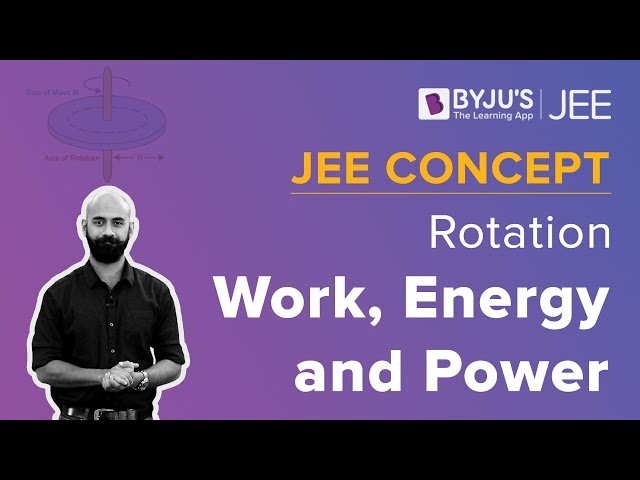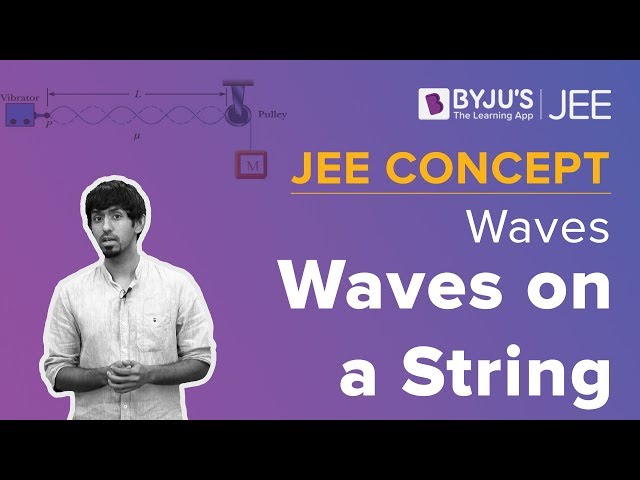
a) 13/23
b) 13/15
c) 15/13
d) 23/13
Distance of centroid from (point P) centre of sphere = (2/3)×(v3d/2) = d/v3
By Parallel axis theorem,
Moment of Inertia about P = 3[ (2/5)M(d/2)2 + M(d/v3)2] = (13/10) Md2
Moment of Inertia about B = 2[ (2/5)M(d/2)2 + M(d)2] + (2/5)M(d/2)2 = (23/10)Md2
Now ratio = 13/23
Answer:(a)

a) 17/54
b) 18/54
c) 18/34
d) 21/34
For solid sphere,
Field inside sphere, E = ?r/3e0
And field outside sphere, E = ?r3/3r2e0
where r is distance from centre and R is radius of sphere.
Electric field at A due to sphere of radius R (sphere 1) is zero and therefore, net electric field will be because of sphere of radius R/2 (sphere 2) having charge density (-?)
EA = – ?R/2(3 e0)
|EA| = ?R/6 e0
Similarly, Electric field at point B = EB = E1B + E2B
E1B = Electric Field due to solid sphere of radius R = ?r/3e0
E2B = Electric Field due to solid sphere of radius R/2 which having charge density (-?)
=
= -?R/54e0
EB = E1A + E2A = (?R/3e0) – (?R/54e0)
= 17 ?R/54e0
Answer: (c)
a) 3/2
b) 2/3
c) 2
d) 1/2

BA =
BB = µ0i(2a)/2p(2a)2 = µ0i /4pa
BA/BB = 4/6 = 2/3
Answer: (b)

a) 1 J
b) 1/2 J
c) 2 J
d) 3/2 J
= ½ + ½
= 1 J
Answer: (a)


For process 3 – 1; Volume is constant;
For process 1 – 2, PV? Constant , and PV = nRT therefore TV?-1 = Constant ;
therefore as V increases T decreases and also relation is non linear, so curve will not be a straight line.
For process 2-3; pressure is constant , therefore V = kT
From above, correct answer is option a.
Answer: (a)
a) i -3j-2k
b) -i-3j+2k
c) i+3j-2k
d) -i+3j-2k
The electric dipole of moment p = q.a where a is distance between charge.
Electric field E at position r is given by
along tangential direction , where
Since already in question,
This means field is along tangential direction and dipole is also perpendicular to radius vector.
Since electric field and dipole are along same line, we can write
From option, on putting ? = -1× 1029 , we get,
Answer: (c)
a) Fall vertically downward towards the planet.
b) Continue to move in a circular orbit
c) Escape from the Planet’s Gravitational field
d) Start moving in an elliptical orbit around the planet
By conservation of linear momentum and taking velocity inline for maximum momentum transfer in single direction.
(m/2)(V/2) + mV = [m + (m/2)]Vf
Vf = 5V/6
Where V is orbital velocity
Escape velocity will be v2V and at velocity less than escape velocity but greater than orbital velocity (V), the path will be elliptical. At orbital velocity (??), path will be circular. At velocity less than orbital velocity path will remain part of ellipse and it will either orbit in elliptical path whose length of semi major axis will be less than radius of circular orbit or start falling down and collide with the planet but it will not fall vertically down as path will remain part of ellipse. Hence the resultant mass will start moving in an elliptical orbit around the planet.
Answer: (d)
a) 3mu2/4
b) v2mu2/v3
c) mu2/3
d) mu2/8
Let v1 and v2 be the final velocities after collision in x and y direction respectively.
Conserving linear momentum
By equating i and j
v1 = 3u/4
v2 = u/4
Initial K.E = (mv2/2) + (m/2)×(u/v2)2 = 3mu2/4
Final K.E = (2m/2)×(uv10/4)2 = 5mu2/8
Change in K.E = (3mu2/4) – (5mu2/8) = mu2/8
Answer: (d)
a) 5.8 I0
b) I0
c) 3 I0
d) 0.2 I0

Amplitudes can be added using vector addition Aresultant =(v2+1)A
Since, I ?A2, Where ?? is intensity.
Therefore, Ires = (v2+1)2 ??0 = 5.8 ??0 (approx.)
Answer: (a)

a) 2720 cm
b) 2420 cm
c) 1810 cm
d) 3020 cm
Using equation of continuity
VA ×AreaA= VB ×AreaB
40VA=20VB
2VA = VB
Using Bernoulli’s equation
PA + ½ ?VA2 = ???? + ½ ??VB2
PA – PB = ½ ?? (VB2 – VA2 )
?P = ½ 1000( VB2 – VB2/4
= 500×3VB 2/4
VB = v(?P×4/1500)
= v(700×4/1500)
= v(28/15)m/s
Volume flow rate = VB×AreaB
= 20 × 100 ×v(28/15)cm3/s
= 2732.5 cm3/s
So, answer comes nearly 2720 cm3/s
Answer: (a)
a) 0.01 cm
b) 0.001 cm
c) 0.001 mm
d) 0.02 mm
Pitch = 3/6 = 0.5 mm
Least count =Pitch / number of divisions
= 0.5mm/ 50
= 1100mm
= 0.01 mm
= 0.001 cm
Answer: (b)
a) 60 m
b) 20 m
c) 600 m
d) 200 m

Minimum angle for clear resolution,
?= 1.22 (?/a)
d = 1.22 (?/a)d
r = 4×108 m
Aperture, a = 5
= 5500 A0
Distance = r d
= 4×108 ×1.22 (5500×10-10/5)
= 53.68
Nearest option is 60m.
Answer: (a)
a) 1.8 eV
b) 0.8 eV
c) 1.1 eV
d) 1.6 eV
From photoelectric equation,
hc/?=W+K.E max
Where, hc = 12400 eV A°
?12400/6561=W+K.E max
?1.89 eV=W+K.E max …(1)
Radius of charged particle moving in a magnetic field is given by
r = mv/qB
½ mv2 = K.Emax = eV
?V=0.8 V
So, K.Emax=0.8 eV
Substituting in (1),
1.89 =W+0.8
i.e. W=1.1 eV (approx)
Answer: (c)
a) 3E
b) E
c) 2E
d) 4E
?? = h/????
= hv(2??(????))
??? ? 1v????
??/??/2 = v(?????? / ??????
4?????? = ??????
???? = ?????? -??????
= 4??????-??????
= 3??????
= 3??
Answer: (a)
a) area
b) energy
c) volume
d) momentum
hc = E?
[E] = [ML2T-2]Therefore [hc] = [ML3T-2] [c] = [LT-1] [G] = [M-1 L3T-2]
v(hc5/G) = [ML2T-2]
The above dimension is of energy.
Answer: (b)
a) 3hv2/4
b) h/v2
c) h/3v2
d) h/2(v2+1)
Assume, air is present outside container

Apparent height as seen from liquid 1 (having refractive index ??1 = v2 ) to liquid 2 (refractive index ??2 = 2v2)
D = h??1/??2 = h/2
Now, actual height perceived from air, h + h/2 = 3h/2
Therefore, apparent depth of bottom surface of the container (apparent depth as seen from air (having refractive index ??0 = 1) to liquid 1(having refractive index ??1= v2 )
= (3h/2)×(??0/ ??1 )
= (3h/2)×(1/v2)
= 3h/2v2
= 3v2h/4
Answer: (a)

a) 0.4 A
b) 2 A
c) 0
d) 4 A
Since resistance 1 O and 4 O are in parallel
???’ = 4×1/(4+1) = 4/5
Similarly we can find equivalent resistance (??”) for resistances 2 O and 3 O
???’’ = 6/5
And ??’ and ??” are in series
? ???????? = (4/5) + (6/5) = 2 O
So total current flowing in the circuit ‘??’ can be given as
?? = ??/???????? = 20/2 = 10A
Current will distribute in ratio opposite to resistance.
So, distribution will be as

So current in the branch BC will be ?? = (4??/5) – (3??/ 5)
= ??/5
= 10/ 5
= 2 A
Answer (b)
a)
b)
c)
d)
Given that the magnetic field vectors are:
Since, the variation of vectors E1 and E2 are along x and y respectively.
Therefore, direction of propagation of vectors E1 and E2 will be along x and y respectively. Since
So, the magnetic field vectors of the electromagnetic wave are given by

Answer (b)
a) 7/9
b) 5/9
c) 3/5
d) 5/7
We know that,
Molar heat capacity at constant volume, ???? = ????/2 (Where f is degree of freedom)
Since, A is diatomic and rigid, degree of freedom for A is 5
Therefore, Molar heat capacity of A at constant volume (Cv)A = 5R/2
Since, B is diatomic and has extra degree of freedom because of vibration; degree of freedom for B is 5 + 2×1= 7 (1 vibration for each atom).
Therefore, Molar heat capacity of B at constant volume (CV)B = 7R/2
Ratio of molar specific heat of A and B = (CV)A / (CV)B = 5/7
Answer: (d)

A. Magnitude of electric field
B. Rate of work done by electric field at P is
C. Rate of work done by both fields at Q is zero.
D. The difference between the magnitude of angular momentum of the particle at P and Q is 2mva.
a) A, C and D are correct
b) A, B and C are correct
c) A, B. C and D are correct
d) B, C and D are correct
Considering statement A
Let, Net work done by magnetic field be WB and net work done by electric field be WE.
By Work-Energy theorem
W??+???? = (1/2)??(2??)2 – (1/2) mv2
? 0+??????2?? = (3/2) ????2
???? = (3/4) ????2 /????
So, statement A is correct
Now, considering statement B
Rate of work done at P = Power of electric force
= ????????
= (3/4) ????3 /??
So, statement B is correct
Now, considering statement C
At Q,
Vector E perpendicular to vector v.
Vector B perpendicular to vector v.
So, dw/dt = 0 for both forces
So, statement C is correct
Now, considering statement D
Angular momentum should be defined about a point which is not given in question but let’s find angular momentum about origin.
Change in magnitude of angular momentum of the particle at P and Q about origin
Hence, ??? = 3mva
So, statement D is wrong.
Answer: (b)
Fluorescent lamp choke will behave as an inductor
By using faraday law to write induced emf,
? -L dI/dt = 0
100 = L(0.25)×103/0.025
L = 100×10-4 H
= 10 mH
Answer: (10)

Breaking stress ?? = T/A
T = ????2l
? ?? = ????2l/??
? ??2 = As/mI
= (4.8×107×10-6)/ 10×0.3 = 16
??? = 4 ??????/??
Answer: (4)
Let v be velocity,a be the acceleration then,
x2 = at2 + 2bt + c
2xv = 2at + 2b
xv = at + b ..(i)
v = (at + b)/x
Now, differentiating equation (i)
v2 + ax = a
ax = a – (at+b)2/x2
a= a(at2 +2bt+c)-(at+b2)/x3
a= ac – b2/x3
a ? x-3
Answer: (3)

If ? of rod is v?? at the moment it hits the ground, then find n.
By using conservation of energy,
mg (??/2)sin30° = (½)(m??2/3)?2
On solving ?2 = 15
??=v15
Therefore, n = 15.
Answer: (15)


We have to apply nodal analysis on both left and right side and check what can be voltage at E. For nodal analysis, voltage at B, F and G will be 0 volts and voltage at A will be 12.7 volt and voltage at H will be 4 volts.
If, we apply Nodal from right side, voltage at E will be 12 volt (diode between A and E will be forward biased). Now voltage at E is 12 volt and voltage at H is 4 volt and since, diode between E and H is reversed biased and any difference of voltage is possible across reverse biased. So, this is possible.
If, we apply Nodal from left side, voltage at E will be 3.3 volt (diode between E and H will be forward biased). Now voltage at E is 3.3 volt and voltage at A is 12 volt and since, diode between E and A is forward biased and in forward biased difference of voltage of 0.7 volt is allowable. So, this case is not possible. Therefore current will also not flow through GH. Hence, VE = 12 V.
Answer (12)























Comments